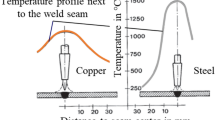Abstract
This article provides an insight into the origin of the radiation emissions during laser beam welding of aluminium and steel alloys. It is the fundamental basis for the development of a system monitoring the welding process of challenging alloys with respect to their chemical composition in the melt pool. To reduce welding faults, e.g. cracks, brittle phases or other metallurgical based defects, a high degree of process knowledge is necessary. This manuscript presents novel spectroscopic investigations used to analyse laser beam welding setups to gain a better understanding of the emission formation. Therefore, also the spatial origin of the emitted radiation of the deep penetration welding process was examined. These empirical results are accompanied by theoretical considerations about the excitation degree of different alloying elements. Together they are a progressive step to develop a system to control the chemical composition of the melt pool during the active welding process. Knowing the composition of the melt allows to control e.g. a filler unit to change the melt composition. The empirical results were conducted by processing common alloys of today’s manufacturing applications.















Similar content being viewed by others
References
Kou S (2003) Welding metallurgy. Wiley, New Jersey
Huber S, Merzkirch M, Zaeh MF, Schulze V (2009) Applications of high-power diode lasers for aluminum welding. SPIE—LASE 2009. High-power diode laser technology and applications VII. SPIE Digital Library, San Jose
Geiger M, Leitz KH, Koch H, Otto A (2009) A 3D transient model of keyhole and melt pool dynamics in laser beam welding applied to the joining of zinc coated sheets. Prod Eng 3(2):127–136
Hügel H, Dausinger F (2004) Fundamentals of laser-induced processes. In: Poprawe R, Weber H, Herziger G (eds) Laser applications. Springer, Berlin
Katayama S (2009) Fundamentals of fiber laser welding. In: Gumenyuk A (ed) International colloquium high power laser welding 2009. Bundesanstalt für Materialprüfung und –forschung, Berlin
Zaeh MF, Huber S (2010) In situ-Legierungsanpassung beim Laser-Tiefschweißprozess. wt Werkstatttechnik Online 6:447–453
Palanco S, Klassen M, Skupin J, Hansen K, Schubert E, Sepold G, Laserna JJ (2001) Spectroscopic diagnostics on CW-laser welding plasmas of aluminum alloys. Spectrochim Acta Part B At Spectrosc 56(6):651–659
Bogaerts A, Gijbels R (1998) Fundamental aspects and applications of glow discharge spectrometric technique. Spectrochem Acta Part B 53(1):1–42
Cremers DA, Radziemski LJ (2006) Handbook of laser-induced breakdown spectroscopy. Wiley, West Sussex
Tendero C, Tixier C, Tristant P, Desmaison J, Leprince P (2005) Atmospheric pressure plasmas: a review. Spectrochem Acta Part B At Spectrosc 61(1):2–30
Dilthey U, Goumeniouk A, Lopota V, Turichin G (2000) Kinetic description of keyhole plasma in laser welding. J Appl Phys D 33:2747–2753
Lieberman MA, Lichtenberg AJ (1994) Principles of plasma discharges and materials processing. Wiley, New York
McNaught AD, Wilkinson A (1997) Compendium of chemical terminology: IUPAC recommendations. Blackwell, Oxford
NIST (2008) NIST atomic spectra database. National Institute of Standards and Technology
Zaeh MF, Braunreuther S, Daub R, Stadler T (2010) Reflected laser radiation—relevance for laser safety? In: Schmidt M, Vollertsen F, Geiger M (eds) Proceedings of 6th international conference on laser assisted net shape engineering. Elsevier, Erlangen
Dudeck S, Rieger D, Puente Leôn F (2007) Direct observation of a laser melt pool surface. In: Proceedings of 13th International SENSOR conference Nuremberg. International Frequency Sensor Association
Trautmann A, Zaeh MF (2008) Novel Insights into porosity formation mechansims in laser beam welding of aluminium. International congress on applications of lasers and electro-optics (ICALEO) 2008. Laser Institute of America, Temecula, CA, USA
Peter L, Claas H, Kurucz R (2010) Kurucz database. Universität Hannover
Beyer E (1985) Einfluss des laserinduzierten Plasmas beim Schweissen mit CO2-Lasern, Darmstadt, Technische Hochschule Darmstadt
Aden M (1994) Plasmadynamik beim laserinduzierten Verdampfungsprozess einer ebenen Metalloberfläche. Fakultät für Maschinenwesen. Aachen, Rheinisch-Westfälische Technische Hochschule Aachen
Vas’kovskii YM, Gordeeva IA, Rovinskii RE, Shirkova IP (1991) Experimental determination of the parameters of a laser jet and verification of ionisation equilibrium. Sov J Quantum Electron 21:984–986
Griem HR (1997) Principals of plasma spectroscopy. Cambridge University Press, Cambridge
Zaeh MF, Huber S, Daub R (2010) In situ melt identification during laser beam welding. International congress on applications of lasers & electro-optics (ICALEO) 2010. CRC Press, Anaheim, USA
Schaeffler A (1949) Constitution diagram for stainless steel weld metal. Metal Prog 56(11):680B
Sibillano T, Ancona A, Berardi V, Schingaro E, Basile G, Lugara PM (2006) A study of shielding gas influence on the laser beam welding of AA5083 aluminium alloys by in-process spectroscopic investigation. Opt Lasers Eng 44:1039–1051
Dudeck S, Rieger D, Puente León F (2006) Zeitlich und raeumlich aufgeloeste Spektroskopie gepulster Laserschweißprozesse. 13te ITG/GMA-Fachtagung: Sensoren und Messsysteme. Freiburg, VDE
Sokolowski W (1991) Diagnostik des laserinduzierten Plasmas beim Schweissen mit CO2-Lasern. Fakultät für Maschinenwesen. Aachen, Rheinisch-Westfälische Technische Hochschule Aachen
Author information
Authors and Affiliations
Corresponding author
Rights and permissions
About this article
Cite this article
Zaeh, M.F., Huber, S. Characteristic line emissions of the metal vapour during laser beam welding. Prod. Eng. Res. Devel. 5, 667–678 (2011). https://doi.org/10.1007/s11740-011-0337-7
Received:
Accepted:
Published:
Issue Date:
DOI: https://doi.org/10.1007/s11740-011-0337-7




